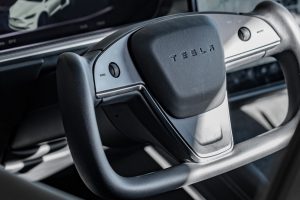- 🚗 Tesla outsold BYD in Q1, regaining the title of the world’s largest EV seller.
- 🔢 Tesla delivered 386,810 vehicles in Q1, while BYD delivered approximately 300,114 BEVs.
- 📉 Tesla’s deliveries marked an 8.5% decline year over year, while BYD fell 43% from its record quarterly high in Q4.
- 🌍 China remains a crucial market for Tesla, while BYD doesn’t sell vehicles in the U.S.
- 💼 Some factors contributing to Tesla’s performance include its operation of fewer factories and larger net profit levels.
- 🤖 Tesla rebranded its Full Self-Driving system as “FSD (Supervised)” and is rolling out v12, free trials, and mandatory FSD demos.
- 🤝 Both Tesla and BYD emphasize the importance of competition in achieving widespread BEV adoption.
- 🌱 Cooperation across the auto industry is essential for making transportation more sustainable.
In the dynamic landscape of electric vehicles (EVs), the battle for supremacy often boils down to numbers – sales figures, market share, and technological innovations. The first quarter of 2024 witnessed a significant showdown between two industry giants: Tesla and BYD. Let’s delve into the insights from their performance and what it means for the future of EVs.
Tesla Regains the Throne 🚗
Tesla’s resurgence in Q1 was remarkable. After briefly conceding the title of the world’s largest EV seller to BYD in Q4, Tesla bounced back, reclaiming its crown. Delivering 386,810 vehicles in Q1, Tesla outpaced BYD by a significant margin. This feat underscores Tesla’s enduring dominance in the EV market.
The Numbers Game 🔢
In the realm of sales metrics, numbers speak volumes. Tesla’s Q1 delivery figures demonstrate its resilience despite facing challenges. Despite a year-over-year decline of 8.5%, Tesla’s delivery numbers remain formidable. On the other hand, BYD experienced a sharp 43% drop from its record quarterly high in Q4. The discrepancy in performance sheds light on the contrasting trajectories of these two behemoths.
The Significance of China 🌍
China, often hailed as the epicenter of the EV revolution, remains a critical battleground for Tesla and BYD. While Tesla continues to expand its footprint in the Chinese market, BYD’s absence from the U.S. market underscores its focus on domestic operations. The divergent strategies employed by these companies underscore the nuanced dynamics of the global EV landscape.
Factors Driving Tesla’s Performance 💼
Several factors contribute to Tesla’s resilience and continued success. Operating fewer factories allows Tesla to maintain efficiency and streamline production processes. Moreover, Tesla’s larger net profit levels provide a financial buffer amidst market fluctuations. These strategic advantages bolster Tesla’s position as an industry leader.
The Evolution of Full Self-Driving 🤖
Tesla’s rebranding of its Full Self-Driving (FSD) system reflects the company’s commitment to innovation. With the introduction of FSD (Supervised) and the rollout of v12, Tesla is pushing the boundaries of autonomous driving technology. Free trials and mandatory FSD demos signal Tesla’s confidence in the capabilities of its autonomous systems.
Collaboration and Competition 🤝
Despite being rivals, Tesla and BYD recognize the importance of collaboration in advancing EV adoption. Both companies have emphasized the role of healthy competition in driving innovation and market growth. This cooperative stance underscores the shared goal of accelerating the transition to sustainable transportation.
Toward a Sustainable Future 🌱
The success of Tesla and BYD is emblematic of the broader shift towards sustainability in the auto industry. Cooperation across the ecosystem, including automakers, policymakers, and consumers, is essential for realizing a future powered by clean energy. As the EV landscape continues to evolve, collaboration and innovation will be key drivers of progress.




